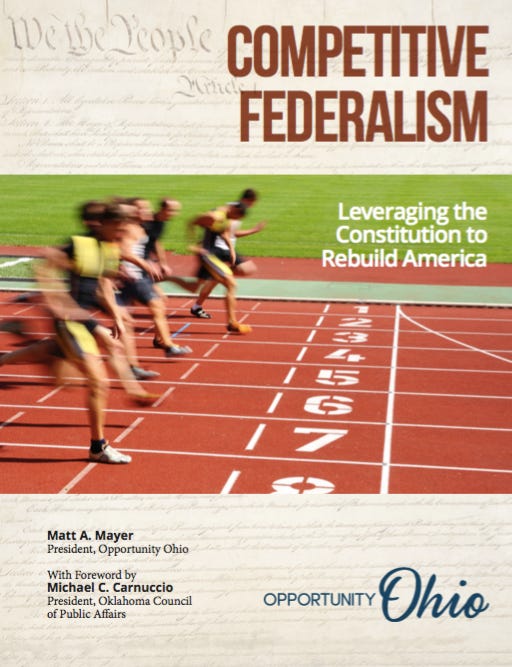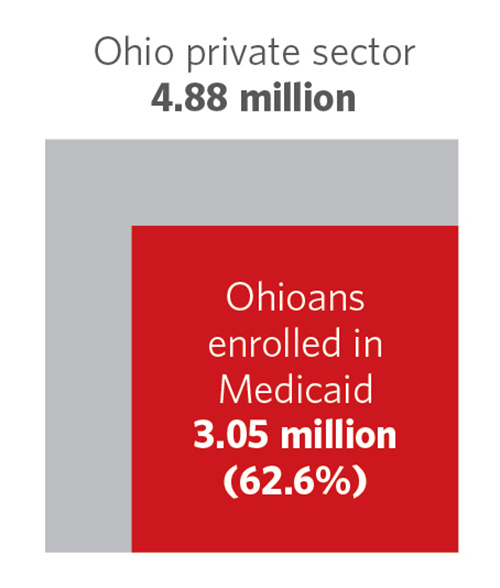Competitive (Anti-)Federalism Is the Key to Fixing America and Driving It Forward
Washington, D.C., will fail us. When it does, the states will determine which Americans prosper and which stagnate. Will Ohio be ready for that competition?
In my last column, I discussed the voter-dependency model the Left employs to grow government via an ever-increasing group of people dependent upon it for their livelihood. As Alexander Tytler famously said, “A democracy cannot exist as a permanent form of government. It can only exist until the majority discovers it can vote itself largess out of the public treasury.” Unfortunately, it isn’t just the Left, as few politicians on the Right have actually ever acted once elected to curb the voter-dependency model. In fact, many Republican elected officials support policies that grow dependency in different ways. The Child Tax Credit is the best example of the Right’s use of the federal government’s power to bestow its largess to citizens. Tax expenditures issued to favored groups, people, or activities are another favorite of politicians. Perhaps you believe that a Trump-Vance Administration will begin the Herculean task of reducing entitlements while at the same time strengthening our military and securing the southern border.
I’m not as optimistic, as Donald Trump has removed Social Security and Medicare reforms from the table and J.D. Vance has proposed expanding the child tax credit. I know it is blasphemy to say so, but I just don’t believe America’s slide to fiscal demise will be reversed or even slowed simply by a growing Trump economy that increases the revenue coming into the federal government’s coffers. Too much annual federal spending is deficit spending (roughly 2/3rds of annual spending) and the national debt has now grown so large that interest on that debt is outstripping every other category. Thus, we’ve entered dangerous territory that a Trump win will make less dangerous. A Kamala Harris win will amplify the danger, as the Left’s unrestrained progressive wish list gets enacted fundamentally changing the fabric of America.
The above is one of the reasons why I am a zealous believer in the power of federalism, which I’ve been writing about and promoting for most of my career. Though we call it federalism, it really should be called anti-federalism or state sovereignty because the Federalist were actually more wrong about how things would go with the federal government than the anti-federalist—the damn “Necessary and Proper Clauses” did indeed become the crack through which virtually any federal action is sanctioned. My third book, The Founding Debate: Where Should the Power Over Our Lives Reside?, presents the five best federalist papers and the five best anti-federalist papers so readers can reach their own conclusion on that question (again, not shilling my books as 100% of profits from my books are donated to the Ronald Reagan Library so I don’t make money off sales). Based on these five per side papers, it seems fairly clear who was right. Here is what one of the writers said:
Whatever law congress may deem necessary and proper for carrying into execution any of the powers vested in them, may be enacted; and by virtue of this clause, they may controul and abrogate any and every of the laws of the state governments, on the allegation that they interfere with the execution of any of their powers, and yet these laws will "be made in pursuance of the constitution," and of course will "be the supreme law of the land, and the judges in every state shall be bound thereby, any thing in the constitution or laws of any state to the contrary notwithstanding."
There is no reservation made in the whole of this plan in favor of the rights of the separate states.
Was that writer Alexander Hamilton, James Madison, or John Jay who we all know by name, or an anti-federalist we’ve never heard of? Regardless, he was 100% right.
More than ever, I think America’s salvation will come from getting as much power and money outside of Washington, D.C., as possible and allowing the fifty “laboratories of competition” to experiment with what works and what doesn’t to meet the needs of their citizens, learning from successes and failures, thereby allowing all boats to rise. This competitive federalism approach simply rejected the one-size-fits-all Washington way in favor of the fifty laboratories of competition approach that history shows works incredibly well (e.g., welfare reform in the 1990s).
Eleven years ago, I published the groundbreaking report, “Competitive Federalism: Leveraging the Constitution to Rebuild America,” in which I made the case to experiment by decentralizing all power and money over Medicaid, transportation, and education to the fifty states with no strings attached. The experiment would allow each state to determine how best to meet the needs of their people. If California wanted a gold-plated Medicaid program, including benefits for illegal immigrants, than it could do so as long as Californians paid the full freight of those policy decisions instead of having those decisions subsidized by taxpayers from other states via federal taxes. Similarly, if Ohio wanted a common sense Medicaid program that limited benefits and had work requirements, it could do so.
Basically, California could do crazy and Ohio could do common sense, with each state solely responsible for paying for those programs without any federal subsidies. People could vote with their feet accordingly.
As you can imagine, such a system would stop the progressive train in its tracks, as left-wing governors and state legislatures, bound by state balanced budget amendments, would finally have to start making touch choices. Federalizing left-wing policies allows states to claim fiscal soundness, but only because they finance their utopias via taxpayers in the conservative states (though many red states also engage in fiscal arbitrage with the federal government). This approach becomes even more consequential as the federal government heads towards bankruptcy. When we finally reach the point at which hyperinflation becomes a reality, the issue of state sovereignty will dominate our discussions.
Why? Because when the federal government starts routinely breaking its promises on Social Security, Medicaid, Medicaid, welfare, and other voter-dependency programs, the best run states that exercise fiscal restraint, promote strong private sectors, and keep dependency from becoming paralyzing will dominate the landscape. Those state also will advocate for a rethinking of America along the same lines. Floridians and Texans increasingly will become leery of being weighed down by the profligate progressive spending of Illinois and New York that only benefits government workers and the Uber-elite, as it increases the burden on the common man. An exhausted and broke Washington, D.C., doesn’t have to mean Texas and Florida also will be exhausted and broke.
All of this discussion leads to the vital issue of state-based leadership. There is a reason everyone points to Florida Governor Ron DeSantis and Texas Governor Greg Abbott as examples of strong leadership, as literally no one points to Ohio Governor Mike DeWine and New York Governor Kathy Hochul on that quality. The pandemic showed once again how powerful state-based leadership can be, as Americans in droves abandoned draconian states like California and New York for freedom-loving states like Florida and Texas. The data charts and tables I put out at Opportunity Ohio every month undergird the notion that Florida and Texas are the places where futures are bright, as Ohio and New York illustrate what slow, painful decline looks like. The former states offer residents and those fleeing Ohio and New York plentiful pathways to prosperity, as the latter offer little more than status quo mediocrity to those who can’t or for whatever reason don’t leave.
It doesn’t have to be this way. No one made DeWine or his right-hand man, Jon Husted, adopt “do nothingness” as their operating standard. Had they spent more time over the last six years reading this column and reviewing my work at Opportunity Ohio and less time listening to progressive pandemic shutdown artist Amy Acton and the political hacks sucking on the government teat around the Capitol, their time in charge could have been enormously consequential in a positive way for Main Street Ohio; instead, they squandered their time in office shutting down Ohio, its businesses, schools, and people severely during the pandemic and wasted supermajorities in the Ohio General Assembly by pushing incremental pale pastel tweaks instead of bold color big ideas that would have pushed Ohio to the top of the rankings.
I hope that after the November presidential election, Ohioans begin to focus on the 2026 gubernatorial election, as there really isn’t much time left to reverse course before Ohio will be so far behind the Floridas and Texases that its decline is irreversible. Washington, D.C., will fail us. When it does, the states will determine which Americans prosper and which stagnate. Will Ohio be ready for that competition?








Right on, Matt! And given how grossly our elected officials have acquiesced , isn't it time to include the states' right to amend the U.S. Constitution? What's wrong with an "all of the above" effort to rebalance the power and jurisdiction of our government? #ArticleV
Well written. I would add that the USA fully for the first roughly 150 years of its existence and the less so but still substantially for the next roughly 40 years after that, didn’t just have federalism in the political sphere, it also had federalism in the economic and scientific spheres (the latter didn’t make it as far), and that the federal regulation of commerce did not, for most of America’s existence, attempt to eliminate all forms of state/local trade inhibitors, it just stepped in to make sure they were not too strong so that there would competition.